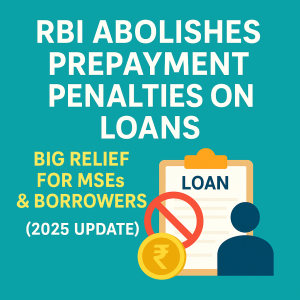In a major step towards ensuring fair practices and encouraging competition in the lending sector, the Reserve Bank of India (RBI) has issued fresh Directions on Pre-payment Charges on Loans, 2025. These new guidelines will make loan prepayments more transparent, affordable, and hassle-free—especially for Micro and Small Enterprises (MSEs) and individual borrowers.
In this blog, we break down what prepayment charges are, what the new RBI rules mean for you, and how you can benefit from them.
What are Pre-payment Charges?
Pre-payment charges (or foreclosure charges) are fees that banks and lenders impose when you repay your loan earlier than the agreed tenure. They are typically used to discourage borrowers from shifting to another lender offering lower interest rates.

Pre-payment penalties have been a common grievance among borrowers—especially small businesses and individuals—who often find themselves locked into costly loans.
RBI’s New Rules on Prepayment Charges (Effective January 1, 2026)
As per the Reserve Bank of India (Pre-payment Charges on Loans) Directions, 2025, here’s what changes:
1. No Pre-payment Charges on Floating Rate Loans to Individuals
- Any floating rate loan given to individuals for non-business purposes will have zero pre-payment charges.
- Applicable to personal loans, home loans, auto loans, education loans, etc.
2. No Pre-payment Charges on Business Loans to Individuals & MSEs
- For loans taken for business purposes by individuals or Micro & Small Enterprises (MSEs):
- Commercial banks, Tier 4 Urban Co-operative Banks, NBFC-ULs, and All India Financial Institutions:
👉 No pre-payment charges irrespective of loan amount. - Small Finance Banks, Regional Rural Banks, Tier 3 Urban Co-operative Banks, State & Central Co-operative Banks, NBFC-MLs:
👉 No pre-payment charges on loans up to ₹50 lakh.
- Commercial banks, Tier 4 Urban Co-operative Banks, NBFC-ULs, and All India Financial Institutions:
3. Applies Even If Loan is Paid from Another Lender’s Fund
- One of the most significant highlights of the new RBI guidelines is that the no pre-payment charges rule applies irrespective of the source of funds used for pre-payment. This means that whether you are using your own savings, business profits, or even refinancing your loan through another bank or financial institution, the original lender cannot impose any pre-payment penalties. Borrowers are now free to switch to another lender offering better interest rates or improved terms of service without facing any financial barriers, thus fostering healthy competition and empowering borrowers with greater financial flexibility.
4. No Minimum Lock-in Period
- Under the new RBI guidelines, borrowers now have the complete freedom to pre-pay their loans at any time without being bound by a minimum lock-in period. Traditionally, many lenders enforced a mandatory waiting period before borrowers could make pre-payments or close their loans early, often tying them to higher interest costs for a fixed duration. With this new rule, borrowers can reduce their debt burden or switch to better loan options whenever they choose, even immediately after availing the loan, without facing any timing restrictions. This move not only enhances financial flexibility but also ensures that borrowers are no longer locked into unfavourable loan terms.
Key Takeaway: No Lock-in, No Restrictions on Pre-payment
Borrowers can now pre-pay their loans at any time—partially or fully—without any lock-in period or timing restrictions. Whether you’re using your own funds or switching to another lender offering better rates, lenders cannot impose any pre-payment penalties. This ensures greater financial freedom, cost savings, and flexibility for individuals and Micro & Small Enterprises (MSEs).
5. Dual Rate Loans: Based on Rate at Time of Pre-payment
- If you have a dual rate loan (fixed + floating), the applicability of prepayment charges will depend on whether you’re on the floating rate at the time of pre-payment.
What Does This Mean for You?
👉 For Individuals:
- You can switch to better home loan or personal loan offers anytime without fear of hidden fees.
- Improves borrower freedom and saves interest costs in the long run.
👉 For Small Businesses (MSEs):
- Easier to refinance expensive loans and access lower cost credit.
- Encourages healthy competition among lenders.
Additional Key Points:
- No prepayment charges if the lender itself initiates early closure.
- No hidden or retrospective fees allowed.
- All terms must be clearly disclosed in sanction letters, loan agreements, and Key Facts Statement (KFS).
When Will These New Rules Apply?
These directions will apply to all loans sanctioned or renewed on or after January 1, 2026.
Conclusion: Borrowers Win, Freedom Restored!
The RBI’s Pre-payment Charges Directions, 2025 are a big win for individual borrowers and small businesses in India. By making it easier to switch lenders and pre-pay loans without penalties, the central bank has enhanced financial flexibility and transparency in the credit market.
Original Notification: https://www.rbi.org.in/Scripts/NotificationUser.aspx?Id=12878&Mode=0#
Mutual Funds: basics of mutual funds
Asset-Allocation by Age: 5 Powerful Asset Allocation Strategies: How to Select the Right Mix of Mutual Funds for Every Age Group
Open Demat account using:
Upstox: https://upstox.onelink.me/0H1s/2QBH4Y
Zerodha: https://zerodha.com/open-account?c=UI9061
FundsIndia:https://www.fundsindia.com/registration/signup?referrer=14c986bdd27841eabe42ce2aaa37815b


